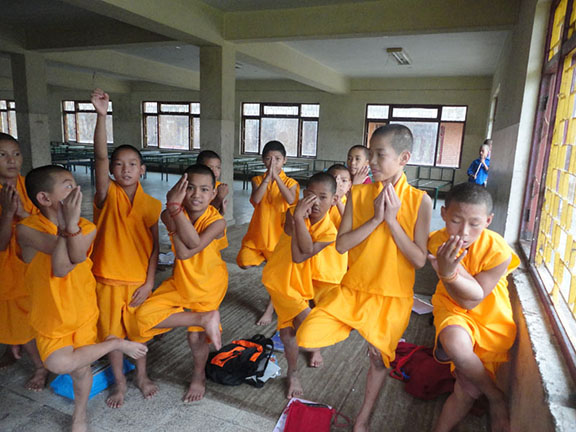 What is the relationship between Yoga and Buddhism? Yoga is often perceived as being focused on the body and Buddhist teachings as emphasizing the study of the mind. In this article, (the late) Michael Stone addresses these issues, explores the connections between the two traditions and how our Yoga practice needs to connect us to the larger world.
What is the relationship between Yoga and Buddhism? Yoga is often perceived as being focused on the body and Buddhist teachings as emphasizing the study of the mind. In this article, (the late) Michael Stone addresses these issues, explores the connections between the two traditions and how our Yoga practice needs to connect us to the larger world.
Integral Yoga Magazine (IYM): How do you define Yoga?
Michael Stone (MS): When I use the term “Yoga,” I’m referring to the Hatha Yoga tradition—which is the tantric practice of waking up the body and which simultaneously awakens the heart and mind—as well as Patanjali’s Yoga model that offers an 8-limbed path that begins and ends with ethics. The word Yoga comes from the Sanskrit word “yuj” which means to unite. Most people translate Yoga as a verb: to do something—to unite the breath and the body or the mind and divinity. But the word means that everything is already inherently and intimately connected—which is also what the Buddha taught. The problem is: We forget we are complete as we are. We are living in times when so many feel a sense of lack, that something is missing. This lack is called dukkha, the Sanskrit word for suffering. We try and satisfy our experience of lack, or emptiness, by trying to secure romantic love, saving enough money and so on. From the Yoga tradition and the Buddha’s teaching, we realize that we can’t actually ground ourselves through objects outside of ourselves.
IYM: What are the common boundaries between Yoga and Buddhism?
MS: The teachings of the Buddha and the teachings of Yoga both begin with the body. When the Buddha taught the Satipatthana Sutta (discourses on mindfulness), his teachings were rooted in opening up to the body as a body, to feel what is going on in the body and to use that to arrive in present experience. Our modern culture is a culture of attention deficit disorder where it’s very hard for us to pay attention. We are distracted and, at the same time, feeling inadequate—so this dovetails into a consumer culture that says to us: You are inadequate so you need to buy this and secure that. Many of us have tried this and it’s only created more anxiety and alienation.
A core teaching is identical in both traditions: karma—that everything we do has an effect. Most people have misunderstood karma as “fate.” There’s a Sanskrit word for fate, which is vipaka. What karma means is not just the effect of our actions but the fact that every time we do something there’s an effect. In the Gita it says, whatever you do there is an effect. You can’t control the outcome, but you can take care of your motivation and intention.
Yoga and Buddhism are similar in their efforts to wake people up to the very foundation of what life is all about. What does it mean to be born, to live a life and to have to die? What are we really committed to? The one place Yoga, Buddhism and many deep spiritual systems converge is in asking us: To what are we really committed? We begin with the body, the breath and we open to the way of how the body really is—tuning into the ways our bodies aren’t balanced, ways parts of ourselves don’t link up with each other. When we start connecting with the breath, dropping deep into the body, we’re dropping into Yoga, into intimacy—the fact that all of this is interconnected.
IYM: Do these two traditions diverge?
MS: Where they are very different is in the way they conceptualize awareness. The Buddha was very distrustful of any language that reifies awareness, which makes awareness into a thing. In early Indian philosophy, before the Buddha’s time, they loved naming awareness. The Buddha reacted to that because he felt that by giving awareness a name, we become too focused on an imagined eternal outside of ourselves or deep inside ourselves and he wanted to bring people’s attention to the here and now of impermanent experience. Although, after his death, many commentators changed their minds and reinterpreted the Buddha’s teaching to sound more Vedantic. Some scholars say that the reinterpretation of the Buddha’s teaching in Vedanta is why Buddhism died in India. On the one hand, the Muslims invaded many Buddhist communities in India and, on the other hand, the Vedantic teachings de-radicalized the Buddha’s emphasis on taking apart language. This began deteriorating the Buddhist movement in historical India. However, the person who is really interesting to study is Patanjali because he seems to land right in the middle. He draws from many of the Buddha’s teachings. For example, Patanjali often uses the term shunya, which means empty. But he also uses a term like Purusha, or pure awareness, to which maybe the Buddha wouldn’t have agreed.
IYM: How are these two traditions misunderstood today?
MS: Sometimes we reduce the Buddha’s teaching to be about the mind and we reduce Yoga to be about the body. We forget that actually both practices begin with a commitment to ethics, to not cause harm, to being honest, to not steal, to use energy wisely and to not be greedy. Then one’s life and practice are the same thing. I always ask students: Is there something in your life that you’re not including in your practice—some decision or some way you are relating to someone that you can include in your practice? Can you look at it through the lens of making a commitment to not causing harm?
Both traditions share the practice of stillness in meditation, of attention to the body and a life that is geared toward activity, not passivity. When the Buddha taught meditation, the first thing he said was to go to the root of a tree, sit cross-legged and follow the breath at the front of the body and to be aware of not controlling your breathing in order to feel the body. Many centuries later, in India and Tibet, these teachings on the body were refined and, in modern Hatha Yoga, we also begin working with the mind by working with the breath. Or, we settle the body with mantra. And you can even say that mantra is the body because you can’t practice mantra without breathing. Both traditions include the body, the mind and our relational lives.
In 2011, in the western world, we can see so many schools and sects that it’s only now that we can appreciate the influence of Buddhism in the Yoga Sutras. We can see how many passages in the Yoga Sutras are identical to the Buddha’s teaching in the Pali canon. This brings us to the most important part of studying two traditions: to see how even though they are separate, whole and complex systems, they can also be reconciled if one’s heart is open. When you go deep into one system, you can see its connection to another system. This year, during Passover, I sat with my family at the table, sang Hebrew songs, ate matzo, laughed and felt great family love. If I didn’t have a Yoga practice, if I hadn’t studied Buddhism, I don’t think I ever would have appreciated Passover the way I appreciate it now. Maybe that’s the funny thing about going deep into a system. You begin to develop a love for other ways of doing things, even the ones you don’t prefer.
IYM: How do we avoid self-centeredness in our practice?
MS: When I tune into the interconnectedness of this body, I also tune into the relationship between my body and the world around me. That way of working internally and then expressing the practice externally is the heart of the Buddha’s teaching and the heart of a socially engaged spiritual practice. We’re not concerned just about our own enlightenment, but with how our lives affect others and how we can serve others. If it’s true that selfish happiness is a dead end, then we come to see that serving others is what opens up our lives. We can then take our inner transformation and help create a social and cultural transformation. When the Buddha said that the self is interconnected he set the stage for a radically engaged social practice—because we’re interconnected, taking care of ourselves means taking care of others. I see Yoga as a practice and as a path of action, which includes stillness and serving the world.
About a century after the Buddha died, there were some disagreements in the sangha. The majority of the community began rethinking what the Buddha’s teaching meant, what the practices meant. They began replacing the idea of perfect enlightenment with the Bodhisattva vow. They deemphasized nirvana as perfect peace and instead emphasized the Bodhisattva vow, which literally means you put aside your own enlightenment to serve others. If we are all interconnected truly, then how can I be free when others are suffering? This question has always motivated me because I’m interested in how formal sitting and asana practice lead to deep states of stillness, while at same time seeing that my sitting practice will not solve our ecological and economic difficulties. So the other half of Yoga is putting my insights into work in the world. Are our practices teaching us to care for our parents who are aging and dying? How can our practice of waking up serve our community? The question I’d pose to our Yoga and Buddhist traditions is this: Can we wake up without others? Perhaps we need others and we can wake up together.
 Michael Stone (1974–2017) was a psychotherapist, Yoga teacher and deeply beloved and respected Buddhist teacher, based in Toronto where he led Centre of Gravity. His teachings integrate the insights of western psychology, the practices of Yoga and the wisdom of Buddhist meditation and philosophy. He is the author of numerous books including, Awake in the World: Teachings from Yoga and Buddhism for Living an Engaged Life.
Michael Stone (1974–2017) was a psychotherapist, Yoga teacher and deeply beloved and respected Buddhist teacher, based in Toronto where he led Centre of Gravity. His teachings integrate the insights of western psychology, the practices of Yoga and the wisdom of Buddhist meditation and philosophy. He is the author of numerous books including, Awake in the World: Teachings from Yoga and Buddhism for Living an Engaged Life.


